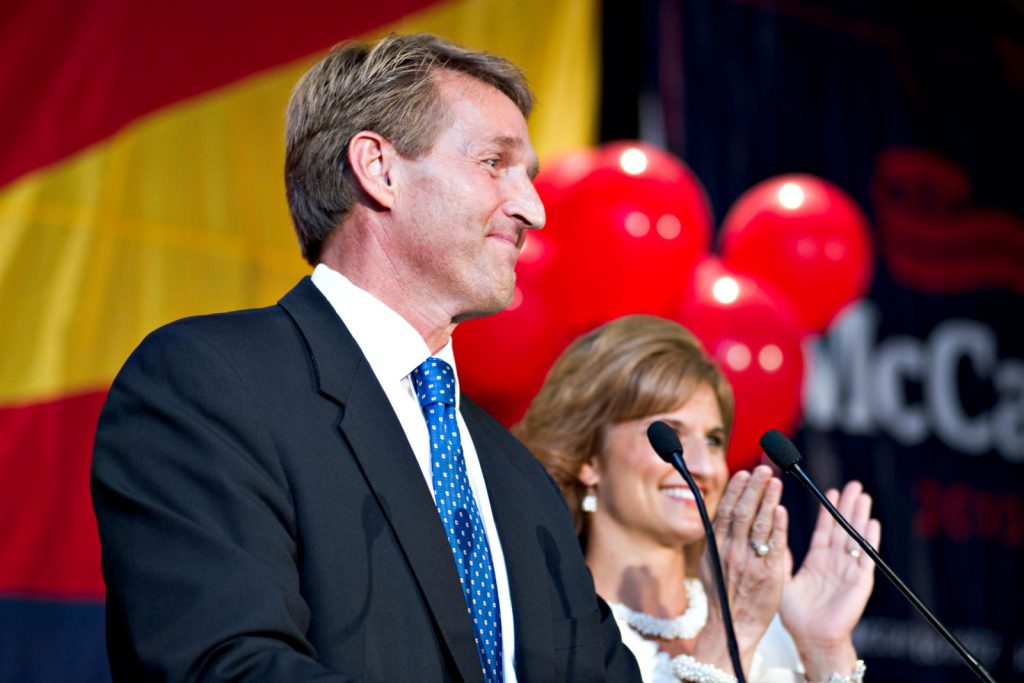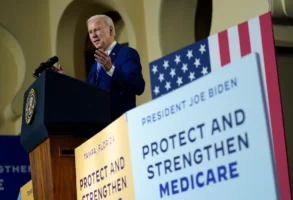
Published November 20, 2017
National Review - November 27, 2017 issue
A year is an eternity in politics, the saying goes. If that’s true, then two years is an eon. And it seems an eon ago that the common wisdom held that the GOP was entering its “libertarian moment,” when the heirs of Barry Goldwater would finally come into their inheritance and retake the party they had long believed was their one true home.
That faction today suffers from PTSD, political-trauma shock disorder. Its champions, Rand Paul and Ted Cruz, were decisively routed in the 2016 Republican primaries. The winner, Donald Trump, is about as diametrically opposed to Goldwaterism as is possible in the GOP, a man who seemingly has no political conscience, much less that of a conservative. The question one hears in any D.C. watering hole is also on the lips of millions of Republicans nationwide: “What has happened to my party?”
Senator Jeff Flake, once a leader of liberty-minded Republicans, said that this departure from past orthodoxy was merely temporary as he announced he was not running for reelection. “This spell will eventually break,” he told his Senate colleagues. And so it shall, if by that he means the current movement to define Republican loyalty as unquestioning loyalty to presidential whims. But the truth he overlooked is that the GOP long ago stopped sacrificing at the altar of small government.
Now it is true that the Republican party is overwhelmingly conservative and that most conservatives oppose high taxes and government direction of society. Polls have shown for decades that Republicans of all stripes believe that the government is doing too much that would be better left to business or voluntary charity. But being opposed to passing something new does not necessarily mean you are also in favor of repealing or modifying something old. And it is when you examine the depth of that sentiment that you find how shallow the commitment to small government is among GOP voters.
In our book The Four Faces of the Republican Party (2016), University of New Hampshire professor Dante Scala and I looked at 20 years of exit-poll data to discern what Republicans believed. We found that at most one in six could be called liberty-minded conservatives, people who wanted both smaller government and lower taxes and made that their principal priority. These voters, whom we called “very conservative seculars,” were the smallest of the GOP’s four factions and had been since at least 1996, when our data series began. Their favorites for the nomination, candidates such as Steve Forbes and Fred Thompson, always lost, and usually quite early, as the favorites of the other GOP factions trounced them in the early states, where momentum is built.
Steve Forbes crashed and burned in 1996 and 2000, and Fred Thompson met an early end in 2008. Mitt Romney, whom many would never have said was a spokesman for liberty-minded conservatives, emerged as their favorite in 2008, but he, too, failed to finish as high as even second place when the primary season was over, as social conservative Mike Huckabee soundly defeated him in a host of contests in conservative states on Super Tuesday. In 2012, it was social conservative Rick Santorum who became the only serious challenger to Mitt Romney, who had already moved to the left in an attempt to capture the GOP nomination.
Candidates who have run as modern Goldwaters have long been an afterthought in presidential politics. This is often obscured by the degree to which hardline conservatives win primaries for lower offices. One must note how they win those races — almost always as avatars of social conservatism, foes of abortion and supporters of religious liberty and tradition. Our research showed that it is these appeals, not the invocations of economic liberty, that move the vast majority of movement-conservative voters.
Very conservative Evangelicals are the second-largest faction of the Republican party and easily the largest throughout a host of largely rural southern and midwestern states. In presidential primaries, candidates who express their worldview, which is focused on God and a defense of Christian culture, easily outpoll economic conservatives. Pat Buchanan, Mike Huckabee, and Rick Santorum have all been favorites of this group, and each at one time emerged as the strongest challenger to the eventual Republican nominee.
This fact explains why Ted Cruz moved from being an apostle for the Tea Party when he was elected to the Senate in 2012 to being a disciple of social conservatism in his 2016 presidential race. He became adept at using the words and adopting the priorities of Evangelical conservatives and launched his campaign at Evangelical-sponsored Liberty University. He also became the first Republican since George W. Bush in 2000 to unite all wings of movement conservatives behind his candidacy. His failure to capture the nomination, however, points to the real reason liberty-minded conservatives are in serious decline: Other conservatives don’t share their small-government convictions.
The largest faction of the GOP are those who tell pollsters they are “somewhat conservative,” and their priorities are quite different from those of liberty conservatives. They like people who do not share the overt religiosity of the very conservative Evangelicals even if they themselves are religious. They always back the very person whom liberty conservatives come to view as the epitome of the “establishment.” In 2000, for example, their support sustained Bush through the early primaries: The two groups of movement conservatives threw their backing behind W. only when the alternative was the much more moderate McCain. So it is that less conservative Republicans are the only party faction who always back the winner.
Trump, as unorthodox as he was in many ways, was simply the latest beneficiary of this fact. He lost both groups of movement conservatives to Cruz in state after state throughout the primary season. He won most states, however, because he was the favorite of the somewhat conservatives and crushed Cruz among the 20 percent of GOP voters who still call themselves “moderates.” (John Kasich was Trump’s biggest rival for these voters.) When Cruz appealed to establishment types, as he did in his home state and in Wisconsin, where Governor Scott Walker endorsed him, he won. But his years of antagonizing their leaders meant that he lacked their support when he needed it most. Cruz carried movement-conservative voters in his final primary in Indiana, but he nevertheless got annihilated, by nearly 17 percentage points, because Trump beat him by 21 percentage points among somewhat conservatives and by a whopping 36 percentage points among moderates and liberals.
Liberty conservatives themselves have changed over the years as well, moving from an emphasis on controlling expenditures to an emphasis on cutting taxes. The now-forgotten 1996 primary fight between Forbes and Senator Phil Gramm of Texas was the turning point. Gramm was a tax-cut backer, but he had earned his political pedigree and fame as an advocate of spending cuts. With Representative Delbert Latta (R., Ohio), he was a co-sponsor of the 1981 Reagan spending-cut proposal. He continued his quest throughout the 1980s, co-authoring the 1985 Gramm-Hollings-Rudman Act, which slowed the rate of federal spending growth. Despite his 15 years of proven small-government conservatism, however, Gramm’s presidential bid never got off the ground.
Social conservatives in ’96 backed Pat Buchanan, delivering a shocking blow to the presumed co–front runner by winning the caucuses in Gramm’s neighboring state of Louisiana. Gramm dropped out after Iowa, where he finished fifth, barely ahead of social-conservative gadfly Alan Keyes. Forbes propelled himself to victory in Delaware and Arizona, and to respectable showings in other states, by presenting a flat-tax plan but not a major spending-cut proposal. Eventually he faded under attack, but he retained the loyalty of liberty conservatives throughout the race until withdrawing after the March Super Tuesday contests, in which he finished behind Pat Buchanan in every state except Connecticut.
Forbes’s run that year changed liberty-conservative politics over the long term. In the 2000 primaries, Bush rose to become the second choice of liberty conservatives because he advocated a supply-side tax cut. It is almost the only domestic policy he pushed through that they still support. Liberty conservatives since then have wooed voters with similar plans, almost never providing details about spending cuts. When House Freedom Caucus leader Representative Mark Meadows (R., N.C.) recently admitted that his group would support the Trump-backed tax cut without insisting on a dime of offsetting spending cuts to help pay for it, he merely demonstrated what has been true for a long time: No serious constituency of the GOP makes spending cuts its top priority.
Even free trade and a welcoming attitude toward immigration, longtime liberty-conservative staples, are under assault in today’s GOP. The Cato Institute’s Emily Ekins recently published a paper, “The Five Types of Trump Voters,” describing the groups that coalesced behind the president in the general election. Only 25 percent were what she labeled “free marketeers” — people opposed to higher taxes and bigger government but supportive of free trade and immigration. A larger number were “staunch conservatives,” and this group opposed illegal immigration overwhelmingly, loved the president’s proposed Muslim ban, and had grown much less supportive of free trade since 2012. A third group, “American preservationists,” nearly a fifth of Trump voters, were even more intensely opposed to immigration and free trade. Steve Bannon is attempting to unite these latter groups against the free marketeers in party primaries.
Every poll conducted before Flake’s announcement showed him badly trailing his announced primary challenger, state senator Kelli Ward. His approval rating among Republicans was extremely low. His case starkly illustrates that if liberty conservatives want to remain relevant in the GOP, they need to adapt. They also need to think seriously about how reductions in spending can be accomplished through a party whose voters are averse to it.
After the Goldwater debacle, longtime National Review editor Frank Meyer argued that traditionalists, anti-Communists, and liberty conservatives should unite, forming a “fusion” of their movements and ideas. That is what happened, but the past 20 years show that the liberty wing is much weaker than it imagined itself to be. It can reinvigorate itself only if it finds a way to make itself relevant to a new conservative fusion.
Editor’s Note: An earlier version of this piece incorrectly stated that House speaker Paul Ryan endorsed Ted Cruz in the 2016 Wisconsin presidential primary. In fact, Ryan did not endorse a candidate during the primaries.
– Henry Olsen is a senior fellow at the Ethics and Public Policy Center and an editor of UnHerd.com. This article appeared in the November 27, 2017, issue of National Review.




